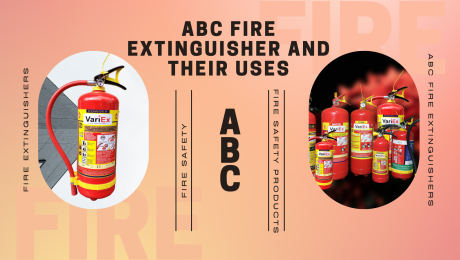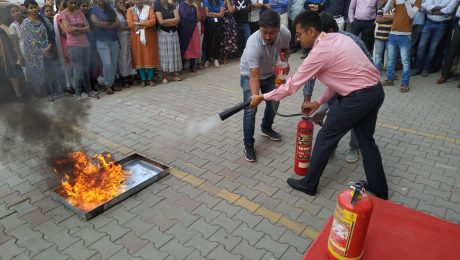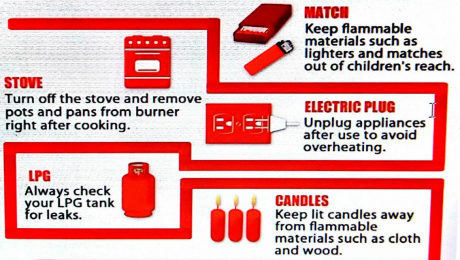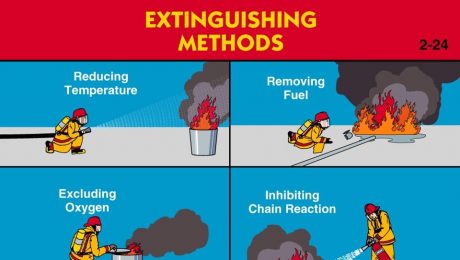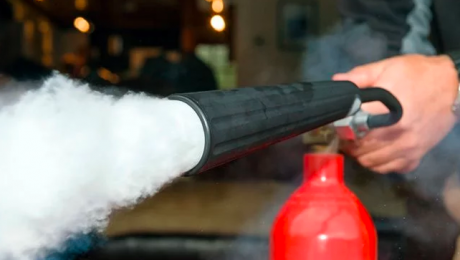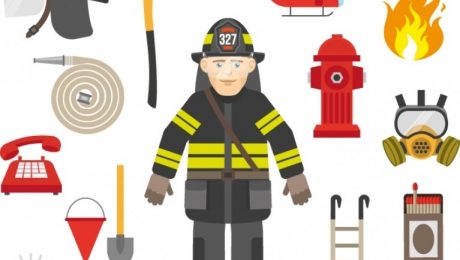A fire extinguisher is a crucial tool in fire safety, designed to suppress and control small fires before they escalate. These portable devices come in various types, each tailored to specific fire classes. ABC extinguishers are versatile, suitable for common combustibles, flammable liquids, and electrical fires. CO2 extinguishers are effective for electrical fires, leaving no residue. Water and foam extinguishers work well on Class A and B fires, respectively. Understanding the PASS technique—Pull, Aim, Squeeze, Sweep—is essential for proper operation. Regular inspections and maintenance ensure reliability. Placing extinguishers in easily accessible locations and providing proper training empower individuals to act swiftly in emergencies. Incorporating fire extinguishers into overall fire safety plans enhances preparedness, making them indispensable tools for protecting lives and property in various environments.
How Long Does A Fire Extinguisher Work?
Thursday, 02 July 2020 by Priyadarshini Nayak
A fire extinguisher can be your first defense against fire as it has a must-have fire safety feature for all businesses and domestic premises. When the time comes to use your fire extinguisher, you want to be confident that it is going to work efficiently. Although most of us have at least one fire extinguisher in stock, many people forget how long they have had them.
It is important to remember that any type of fire extinguisher degrades over time. But, not everyone realizes that fire extinguishers require regular maintenance, and if left in storage for too long, those will no longer work to their fullest potential. In this context, a question arises, how long exactly can a fire extinguisher last before it expires? The answer to this question is well-maintained fire extinguishers can last up to twenty years – according to most manufacturers.
- Published in Fire Extinguisher
No Comments
Go Green A Glance At Two Eco Friendly Fire Extinguishers
Saturday, 20 June 2020 by Priyadarshini Nayak
There is a huge pressure across the national and international levels toward the protection of our environment, which has affected every area of life. Comprehending this fact in mind, several researchers and companies are developing innovative products that play a safe role for the environment. And eco-friendly fire extinguishers are one of them, and that has not been left behind.
- Published in Fire Extinguisher
Top 3 Steps to Choose a Fire Extinguisher for your Home
Saturday, 21 March 2020 by Priyadarshini Nayak
Every home must have at least one Fire Extinguisher mounted in an easily accessible spot or kept readily at hand. A fire extinguisher is an important safety product that every home should have (safety at home), and it can even prevent a disaster caused by fire when used properly. According to the National Fire Protection Association (NFPA), the report reveals that almost half the fires in the home occur in the kitchen, so that’s a good place to start using a fire extinguisher.
- Published in Fire Extinguisher
ABC Fire Extinguishers And Their Uses
Thursday, 20 February 2020 by Priyadarshini Nayak
We all know that every place, whether it’s your home, workplace, or any public place, require to have fire extinguishers just to prevent any kind of fire hazard. However, most of us even don’t know that a single fire extinguisher does not work on all types of fire.
There are many different types of fire extinguishers available to fight with many different classes of fire. Hence, we first of all need to ensure that we have the proper extinguisher installed appropriately for the potential fire hazards for your building for achieving true safety. ABC Fire Extinguisher is one of the most well-known yet very versatile kinds of extinguishers available in the market.
There are five basic classifications of fuel that exist in this sphere. And, the extinguishers are considered with either letter-shaped or pictorial symbols, which specify what types of fires they are proposed for.
2KG fire extinguishers4 KG Fire Extinguisher6 KG Fire Extinguishers9 KG Fire ExtinguishersABC dry powderABC extinguisherabc fire extinguisherABC fire extinguisher and its usesABC fire extinguisher refillingABC fire extinguishers refillingABC powder fire extinguisherABC Powder fire extinguishersABC Type Fire ExtinguisherABC type fire extinguishersAll Types Of Fire Extinguishersautomatic fire extinguisherfire extinguisherFire FightingFire fighting systemfire fighting system in bengaluruFire Safety at Homefire safety equipmentTypes of fire
Importance of Fire Extinguisher Training
Thursday, 13 February 2020 by Priyadarshini Nayak
Fire extinguishers are the foremost part of protecting people and reducing any fire damage when a fire occurs in their home or business. Fire extinguishers are playing a major role in your fire safety plan but, only if you know how to operate the extinguisher properly. It’s not enough to have a fire extinguisher in your home, or at work, you need to understand how it works or usage guide. Comprehending this, a training program for Fire Extinguisher should be provided to the people to familiarize themselves with the operation of the Safety Equipment.
Therefore, it is important to attend the fire extinguisher training sessions. Appropriate fire extinguisher training helps ensure you to know the correct way to assess a fire situation (types of fire). The training will help you hold the extinguisher correctly you may not hurt yourself, or not face any problem extinguishing the fire. You will also be able to know what kind of fire the extinguisher is best suited to extinguish.
- Published in Fire Extinguisher
Fire Extinguisher Safety Tips At Your Home
Tuesday, 04 February 2020 by Priyadarshini Nayak
A fire extinguisher, if it uses properly, can save lives and property. A portable fire extinguisher for your home uses to put out a small fire or control it until the fire department arrives.
There are some important things you need to know during the purchase of a fire extinguisher for your home. Fire extinguishers (safety products) are generally rated for different types of fires such as Class A type extinguisher is suitable for fire, which happens due to regular materials like wood, cardboard, and cloth; Class B type extinguisher is appropriate for fire, which happens due to flammable liquids, such as gas, oil, and grease; Class C type fire extinguisher is used for fire, which arises due to electrical equipment, like wires and fuse boxes.
- Published in Fire Extinguisher
Methods of Extinguishing Fire at Initial Stages
Thursday, 23 January 2020 by Priyadarshini Nayak
Fire is the consequence of a chemical reaction called combustion, which happens because of a combination of fuel, and oxygen as well as a source of ignition. If used irresponsibly, it can cause havoc on life and property as fire is one of the foremost reasons for loss of life and living. Despite advances in firefighting techniques, fire is the biggest reason for the loss of several livings. But it is important to measure the fire before applying any of the methods for extinguishing the fire. For this, you need to read the fire by the smoke’s color, and source (types of fire) and after you have studied the fire, apply the appropriate method intelligently to extinguish the fire as well as minimizes the loss.
There are different safety methods used to extinguish fires. Here’s a list of methods useful for extinguishing a fire at the initial stage.
- Published in Fire Extinguisher
Types of Chemicals Using in Fire Extinguishers
Wednesday, 08 January 2020 by Priyadarshini Nayak
One of the common questions that almost all people ask about the types of chemicals used in fire extinguishers or what chemicals are used in fire extinguishers? The chemical that a fire extinguisher contains depends on the purpose for which it is used. The most common chemical is Sodium Bicarbonate used in the fire extinguisher, and by heating up, it gives carbon dioxide. But today, Potassium Bicarbonate is widely used in fire extinguishers due to its effectiveness as compared to Sodium Bicarbonate.
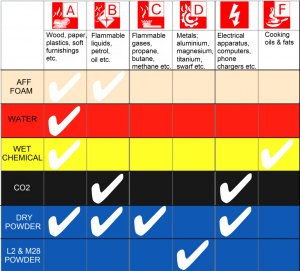
As we stated that fire extinguisher contains the chemicals depending on its application areas, hence for an example, handheld extinguishers (use in garages and kitchens) contain chemicals such as pressurized carbon dioxide, and nitrogen, which are useful in extinguishing the fire. Other types of extinguishers (dry powder fire extinguisher) contain a powder such as potassium bicarbonate (KHCO3), liquid water, and an evaporating fluorocarbon (most commonly used chemical is the bromochlorodifluoromethane (CF2ClBr) referred to as halon 2111) to extinguish the fire.
Fire extinguishers are built in such a way to use in the buildings or other structures to protect. Water sprinklers in contemporary times are the most common systems and using widely due to their economical price, simple to use, and safe from any health hazard. However, the scope of their use is restricted in a fuel storage system, server rooms, and other electrical equipment fitted areas. You cannot use water as a fire-extinguishing agent in places stuffed with electrical equipment. In this case, a firefighting gas like CO2 is an appropriate chemical used to eliminate fire in a confined space. The important thing regarding the CO2 agent is that it works well to put out the fire but, its heavy concentration can be harmful in a place crowded with people.
Nowadays, several fire extinguishers use by utilizing an extensive range of Hydrofluorocarbons (HFC). Such types of extinguishers contain chlorine or bromine atoms, hence they have different effectiveness, especially when it comes to halting the progression of a chain combustion reaction. The extinguishers using HFC chemicals work in due resemblance to CO2 or N2 by absorbing heat and cutting out the supply of oxygen. Even though, various companies are promoting HFCs such as CHF3, C2HF5, and C3HF7 for a variety of applications. In addition to this, some other types of fire extinguishers use a chemical like potassium acetate based agent, discharged from the extinguisher as a fine mist that forms a soapy foam that suppresses vapors, and steams and prevent fire. Mono Ammonium Phosphate is a dry chemical powder or agent used in class A, B, and C types of fire extinguishers. This particular chemical is non-conductive but corrosive, and it can clean up after extinguishing the fire. Sodium bicarbonate (nontoxic, noncorrosive and does not require cleanup on usage) is another kind of dry chemical and used for class B and class C fires.
Final Say
We hope this article has helped to let you know about different types of chemicals, which are used in extinguishers, and of course, as per their application areas.
Know the fire extinguisher chemicals and stay safe from any fire hazard!
- Published in Fire Extinguisher
How to Use a Fire Extinguisher with a 4-step Process
Saturday, 05 October 2019 by Priyadarshini Nayak
Fortunately, you’re lucky that have not experienced any fire tragedy! But imagine if any fire mishaps, how would you react? Do you have any idea to do what during a fire emergency? The answer is to operate a fire extinguisher correctly. Therefore, we all should learn the process of using a Fire Extinguisher to avoid the minor damage and a full-scale disaster at your home or business.
Comprehending this fact in mind, I am going to discuss the fire extinguisher guide, which describes the proper methods and proceedings to use it. In this blog post, you will get guidance to use a fire extinguisher properly and also helps to evacuate safely if the fire gets massive despite your efforts.
Now a question comes, what are the 4 steps in using a Fire Extinguisher? Consider the list of the following 4 steps to use a fire extinguisher accurately.
Distinguish the fire classification (what kind of fire)
When any fire tragedy occurs, it seems a fire mishap. But you should know that the fire categorizes into different classifications. And, it’s essential to know, what type of fire you’re trying to put out, especially when thinking to buy a fire extinguisher. The different kinds of fire or its classification named as Type A, Type B, Type C, Type D, and Type K and this 5-letter naming system is capable of helping you in using the right type of fire extinguisher.
It’s also important to remember that the type of fire depends on what’s burning, and therefore you’ll be able to use the right type of fire extinguisher. Have a look below to the different types or classes of fires.
- Type A – Fire happens linking to wood, paper, cloth, rubber, and many plastics.
- Type B – Fire occurs due to flammable liquids and gases or wet chemical including gasoline, solvents, propane, and paints
- Type C – Fire mishaps involving energized electrical equipment, including fuse boxes, wiring, control panels, computers, copiers, machines, and appliances (anything plugged into electricity).
- Type D – Fire tragedy arises concerning metals, including combustible powders, shavings, or flakes of metals such as magnesium, titanium, potassium, sodium, and other dry chemicals.
- Type K – Fires involving cooking oil and fats (uses in commercial kitchens).
 (Image Source: Comfire.ca)
(Image Source: Comfire.ca)
Get the accurate type of fire extinguisher
Get the accurate kind of fire extinguisher to put out the fire, and check the correct one after knowing the type of fire. For instance, if you face a Type B fire, then you need a fire extinguisher that enables you to put out the same type of fire, which you’re experiencing. Understanding this point, now a question arises how do you know the type of fires that a fire extinguisher can put out? The answer is to look at the label highlighted on the fire extinguisher. It will help you to understand what type of fire it is to which the fire extinguisher can safely put out.
There are some extinguishers those can only put out one type of fire (extinguisher with an “A” rating puts out the only Type A fires); some other fire extinguishers can put out different types of fire (a fire extinguisher with an A, B, and C rating put out Type A, Type B, and Type C fires). VariEx is one of the trusted manufacturer, supplier, and dealer of fire extinguisher that helps in extinguishing the fire of every type.
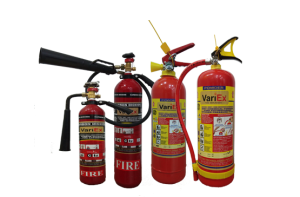
Follow the PASS method for using a Fire extinguisher
People will want to use the extinguisher to put the fire after they get to know the type of fire, and selection of a suitable fire extinguisher. But this not enough to use an extinguisher because everybody does not know how to use an extinguisher. Hence, there’s a step by step method that anyone can follow to use a fire extinguisher correctly, and the method is known as PASS.
Let us explain the steps of fire extinguisher procedure (PASS) to operate a fire extinguisher.
- P for Pull: Pull the pin (it may break the tamper seal) while holding the extinguisher away from you to unlock the device.
- A for Aim: Aim low and indicate the nozzle of the extinguisher towards the base of fire. It is recommended not to touch the horn on a CO2 extinguisher as it gets very cold that can damage the skin.
- S for Squeeze: Squeeze the knob or handle of the extinguisher to release the extinguishing agent.
- S for Sweep: Sweep the nozzle from side to side at the base of the fire, the fuel source, until the fire is out.
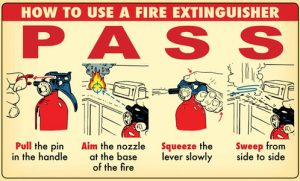 (Image Source: Firstlinefire.com)
(Image Source: Firstlinefire.com)
What time to leave to fighting the fire and evacuate the fire part?
When you fight the fire actively, remember there may be cases when you’ll have to give up, quit fighting the fire, and evacuate the fire area for your safety. Here is a list of reasons to quit fighting a fire and to evacuate yourself immediately:
- If the fire is spreading too quickly
- If the fire might block your only exit
- In case the fire is too massive
- Even when the fire is so hot you can’t get close enough (10-15 feet) to fight it effectively
- The minute you’ve had to get down on your knees because you can’t see well; otherwise, because of high temperature, or smoke
Last Word
We hope this blog post has made you found the best answer to how to use a fire extinguisher. Check your house or office or shop to make sure that you have the appropriate fire extinguishers available.
STAY SAFE!!
- Published in Fire Extinguisher
Top 3 Fire Safety Equipment To Install In Your Home
Saturday, 14 September 2019 by Priyadarshini Nayak
Fire Safety is an essential matter for all of us. Many people may not face a major fire tragedy, but don’t be sure that it will never happen to them in the future. Fire is an unpredictable catastrophe that can occur at any time, and therefore, everyone should prepare for such possibilities. The main purpose of fire safety services is to prevent loss of life, protect building occupants from injury, and avoids property damage.
Fire safety equipment is vital for every building, be it residential, commercial, or industrial, and executed in any renovation, or construction project. As Indian law says, fire safety equipment is mandatory to install for any developed property. Even it is mandatory for some cities or states to install fire and safety equipment in schools, colleges, shopping malls, and other high-rise buildings or apartments.
It’s necessary to put out a fire with safety equipment before it becomes uncontrollable, and potentially even endangering lives. When a disaster like fire mishaps strike, detectable safety equipment should be there within your reach and guidelines on how to use them in case of an emergency.
Here are the top 3 fire safety equipment that you need to install in your home:
Fire Alarm / Smoke Detector
Fire Alarm or Smoke Detector is the most important fire safety equipment used to prevent fire tragedy. The fire alarm on VariEx brand produces an early warning sound or visual effect through the alarm when it detects smoke. It is also capable of alerting people before the fire turns into a severe one.
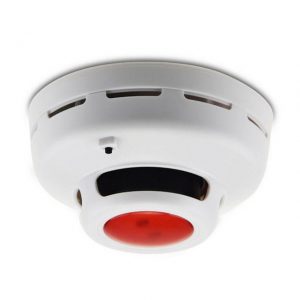
Response to a detected fire depends on the proper installation of a battery-operated fire alarm system which is powerful, and cost-effective in saving lives and property. Smoke detectors are available and covered in plastic enclosures with varying shapes and sizes. And make sure automated fire detection systems are well-maintained, tested, and communicated with the fire alarm control panel.
Fire Extinguisher / Fire Suppressor
A fire extinguisher is one of the best fire safety equipment or fire safety materials used for extinguishing a small fire before it becomes irrepressible or uncontrollable. A fire extinguisher or fire suppressor comes the next after fire detection, which is used to prevent the fire from spreading massively. VariEx’s fire safety equipment for home (First Aid firefighting equipment) uses dry chemicals, wet agents, or a gaseous substance to suppress or extinguish the fire.
A fire extinguisher is comprised of a cylindrical pressure vessel, containing any of the above-mentioned agents, used to extinguish a fire. These are the parts that any fire extinguisher can use for its operation. It is important to install at least 1 kg or 2kgs powder, or 2l foam fire extinguisher for your home, which gives you multipurpose coverage and versatility. Water sprinkler systems, inert gas systems, clean agent systems, vehicle fire suppression systems both automated and manual are some of the types of home fire extinguisher or fire suppressor. People can purchase it as per their budget suits because fire extinguisher price is indeed affordable.
Fire Safety Signage
Fire safety signage or fire safety sign board (glow sign board / LED sign board) is divided into two types, i.e. Fire Exit Signage and Fire Door Signage. These are known as firefighting systems for Building. Fire exit signage is essential for a bigger or more complex building and to determine your primary exit route even when a fire happens. Fire exit signage assists to exit in the shortest and quickest route out of a building in an emergency situation.
Fire door signage is again crucial to slow down the spread of fire in that particular building. When it is closed, it acts as a barrier to help prevent the fire from spreading, and when it opened that allows as a means of escape.
Certain indications of the signage (white text on blue background) are mandatory to take a proper course of action if it is necessary. And the best part of fire door signage is the sign, which gets displayed on both sides of the door. Some of the indications are-
- Fire Door Keep Shut uses for fire doors that need to be closed when not in use.
- Fire Door Keep Locked Shut uses for fire doors that must be kept locked when not in use.
- Automatic Fire Door Keep Clear also uses for doors that are held open by an automatic mechanism.
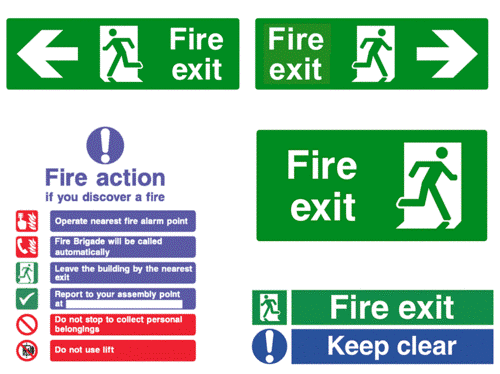
(Image Source: Indiamart.com)
Last Word
The importance of fire safety cannot exaggerate. Staying safe can save you, and your building from destruction, so it is advisable to prepare always.
- Published in Fire Extinguisher





